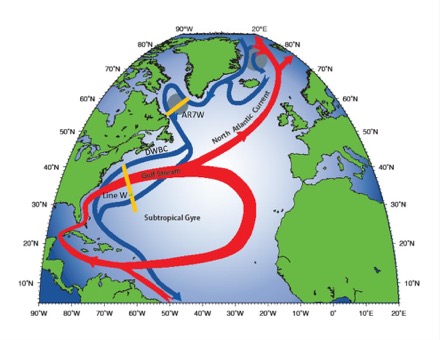Source: Journal of Geophysical Research: Oceans
Part of the global oceanic circulation system, the Atlantic Meridional Overturning Circulation carries warm Atlantic surface waters north toward the Arctic and colder, saltier deep waters south toward the equator. Because this convection cell transports enormous amounts of water and heat around the Atlantic basin, it exerts an important influence—fluctuations in its strength can impact regional and global climate, biogeochemical cycles, and ecosystems.
Previous studies have calculated the timescales for the transport of water in the North Atlantic using many different methods, but the results have varied by an order of magnitude. To address this discrepancy, Smith et al. studied the fate of chemicals previously introduced to the environment that can act as tracers.

Specifically, the researchers turned to iodine-129, a long-lived radioactive isotope that has been discharged into North Atlantic coastal waters from the nuclear fuel reprocessing plants at La Hague, France, and Sellafield, U.K., since the late 1960s. They also examined anthropogenic chlorofluorocarbon (CFC)-11, a refrigerant that had been released to the atmosphere since the 1940s but was phased out of use after the Montreal Protocol entered into force in 1989. Although released into the atmosphere, CFC-11 entered the surface ocean. The concentration of iodine-129 surged in the early 1990s as did CFC-11 from 1968 to 1990. The moving “concentration fronts” are unique tools that the team harnessed to track the movement of deep waters in the North Atlantic.
The researchers measured iodine-129 and CFC-11 concentrations along three transects: one in the Labrador Sea and one southeast of Cape Cod biannually or annually for 10 years (2004–2014) and a third southeast of Bermuda in 2010. They then compared these data with the expected tracer distributions based on a boundary current model.
The results show that the cold bottom water takes 5 to 6 years to travel from the Labrador Sea to the transect southeast of Cape Cod. This travel occurs with an average velocity of 2.7 centimeters per second. The water takes about 9 years to reach the south flank of the Bermuda Rise. The team also determined that significant mixing occurs between the boundary current core and ocean interior, which exerts a general controlling influence on tracer distributions.
In conjunction with other measurements, these results paint a clearer picture of the pathway by which circulation overturns in the North Atlantic. They offer important insight into the speed and behavior of the North Atlantic’s deep waters and an improved understanding of the relative importance of branching pathways for the circulation of heat and water throughout the region. (Journal of Geophysical Research: Oceans, doi:10.1002/2016JC011759, 2016)
—Terri Cook, Freelance Writer
Citation:
Cook, T. (2016), Tracing the North Atlantic’s bottom waters, Eos, 97, https://doi.org/10.1029/2016EO062943. Published on 16 November 2016.
Text © 2016. The authors. CC BY-NC-ND 3.0
Except where otherwise noted, images are subject to copyright. Any reuse without express permission from the copyright owner is prohibited.
